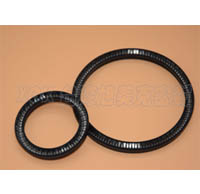Common performance parameters for rubber seals
1、 compression performance
Rubber seals are usually in a compressed state, due to the viscoelasticity of the rubber material, the pressure will decrease with time, the performance of the compressive stress relaxation; remove the pressure can not return to the original shape, the performance of compression and permanent deformation. This phenomenon is more pronounced in high temperature and oil media, which is directly related to the durability of the sealing capacity of the sealing article.
2、 hardness
Hardness means that the sealing material to resist external force into the ability, but also one of the basic properties of sealing materials. The hardness of the material to some extent related to other properties, the higher the hardness is relatively strong, the greater the elongation, the better the wear resistance.
3、 tensile properties
Mainly include: tensile strength, tensile stress, elongation at break and tear the amount of permanent deformation. Tensile strength is the maximum stress at which the specimen is stretched to fracture. The tensile stress (modulus) is the stress achieved at the specified elongation. The elongation is the deformation caused by the specified tensile force of the specimen, and the ratio of the extension to the original length. The elongation at break is the elongation at which the specimen is pulled. The permanent deformation of the specimen is the residual deformation between the marks after the tensile fracture.
4、 low temperature performance
The following describes two methods of testing low temperature performance: 1) low temperature retraction temperature: the sealing material stretched to a certain length, and then fixed, quickly cooled to below the freezing temperature, to achieve equilibrium The test pieces were released and the temperature was raised at a constant rate. The temperature of the recording was 10%, 30%, 50% and 70%, respectively, with TR10, TR30, TR50, TR70. The material standard is TR10 as an indicator, which is related to the brittle temperature of the rubber. Low temperature flexibility: the sample at a specified low temperature after freezing to a specified time, according to the provisions of the angle of reciprocating bending, inspection of the seal at low temperatures after repeated effects of dynamic load after the sealing capacity of the pros and cons.
5、 oil resistance or resistance to media performance
Sealing material in addition to contact with petroleum-based, diester, silicic acid oil, the chemical industry sometimes contact with acid, alkali and other corrosive media. In addition to corrosion in these media, at high temperatures will also lead to expansion and strength reduction, hardness reduction; while the sealing material in the plasticizer and soluble substances are extracted, resulting in reduced quality, volume reduction, causing leakage. Generally, the quality, volume, strength, elongation and hardness of the sealing material are measured at a certain temperature after soaking in the medium for several times to evaluate the resistance of the sealing material to the oil resistance or resistance to media.
6、 anti-aging performance
Sealing material by oxygen, ozone, heat, light, moisture, mechanical stress will cause deterioration of performance, known as the aging of the sealing material. Aging resistance (also becomes weatherability) can be expressed by the change in strength, elongation and hardness after aging. The smaller the rate of change, the better the aging resistance.






